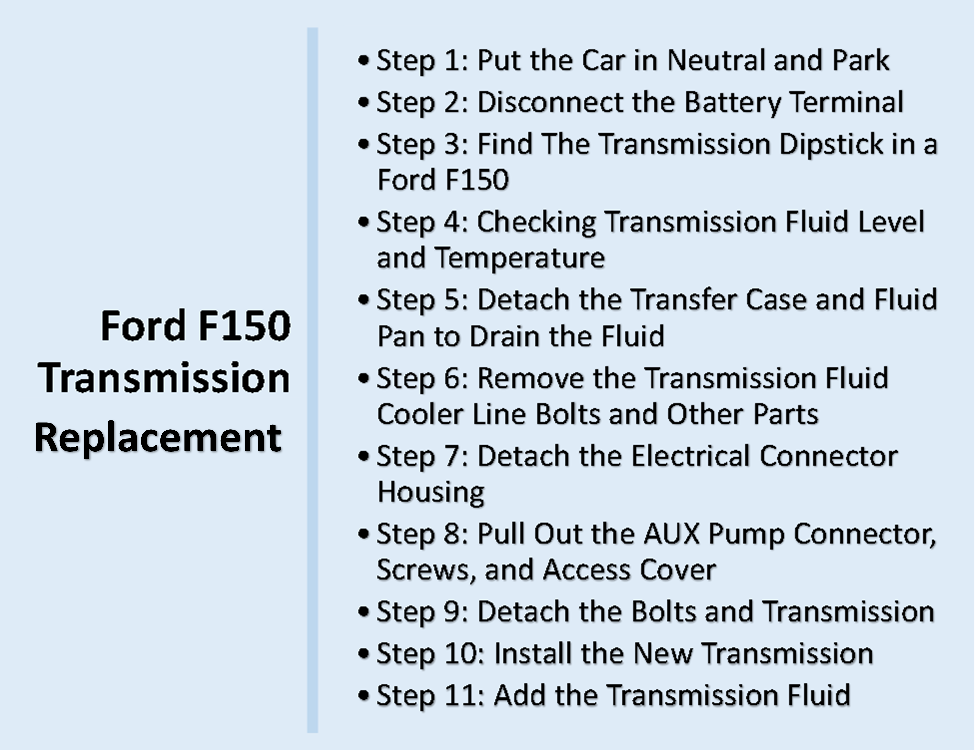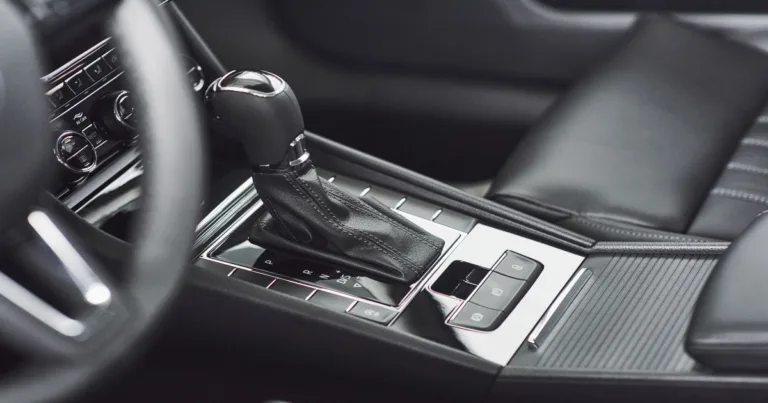To replace the F150 Ford transmission, you’ll need to prepare the car and then check the fluid properly. Next, take out the transfer case and fluid pan. After that, drain the fluid and detach all the related parts to the transmission before changing it. Lastly, refill the fluid.
After many years of use, the F150 car’s transmission might need replacing. To save money, many people prefer the DIY approach, and if you’re one of them, this guide is for you.
Table of Contents
Ford F150 Transmission Replacement Steps
Let me walk you through the step-by-step procedure of how you can change the Ford F150 transmission in the proper way:

Step 1: Put the Car in Neutral and Park
You’ll need to begin the process by putting the gear to Neutral and then inserting the transmission jack under the car.
Then, lift the car upward. After that, idle the car and shift the gear to Park to ensure the transmission fluid is getting hot.
Step 2: Disconnect the Battery Terminal
After that, open the hood of your F150 car and secure its position. Then, locate the battery by checking the owner’s manual as the spot varies based on the model year.
Next, disconnect the negative battery terminal’s cable from the battery box after unscrewing the bolt with a ratchet wrench. Then, use a towel to place the open cable and ensure it’s not interacting with other gears.
Step 3: Find The Transmission Dipstick in a Ford F150
You’ll now need to find the transmission dipstick in your F150 car. It’s either near the engine bay (under the hood) or transmission housing (under the car). For a better understanding, read here to know the exact F150 transmission dipstick location.
Note: If you have other Ford series like Focus, Escape, and so on, learn here the location of the transmission fluid dipstick.
Step 4: Checking Transmission Fluid Level and Temperature
When you are checking the fluid level, you’ll need to put the gear in park and idle the engine for a few minutes. For a clearer explanation, be sure to check this guide about whether you should check the transmission fluid in Park or Neutral.
Then, just use the clean dipstick inside the transmission tube and check its level. You can check this guide about checking the fluid level to know the procedure in detail.
After that, you’ll need to either use a scan tool or the dipstick with the Hot and Cold reading indicator to know the temperature of the fluid. To know it in a better way, read this guide about checking transmission fluid temperature.
Step 5: Detach the Transfer Case and Fluid Pan
- Take off the engine cover and unplug the oxygen sensor connector on the left (driver’s side) valve cover at the back.
- Then, unplug the oxygen sensor connector on the left and right (driver’s and passenger’s) valve cover at the back.
- After that, remove the starter. If you want to learn every detail, check out the guide about the F150 not starting where I explain it.
- Next, take out the driveshafts. In that case, use a ratchet wrench to detach the bolts.
- Then, remove the front stabilizer bar and any skid plates, if your vehicle has them.
- Following that, remove the transmission pan heat shield and detach the insulated transmission cover.
- Let the transmission fluid drain out after detaching the drain plug using the ratchet wrench. Then, remove the left and right (driver’s and passenger side) catalytic converter assembly.
- Afterward, take out the transmission mount. Then, unplug the vent tube at the top of the transmission, behind the bell housing.
- Finally, take off the shift lever shield if it’s there.
Step 6: Remove the Transmission Fluid Cooler Line Bolts and Other Parts
- Next, take out the bolt holding the transmission fluid cooler line. Then, release the lines from the bracket near the oil pan and move them aside. After that, throw out the O-rings if in bad condition.
- Then, detach the shift cable from the adjuster. Ensure to take out the bolt and cable from the bracket.
- After that, disconnect the bolt holding the fuel line bracket at the top of the back of the transmission. Now, disconnect the transfer case vent tube. Then, unplug the transfer case shift motor electrical connector and the harness clips.
Step 7: Detach the Electrical Connector Housing
At the back of the transmission on the right side, just twist the electrical connector housing, and then gently pull it out from the transmission.
Step 8: Pull Out the AUX Pump Connector, Screws, and Access Cover
You’ll now need to unplug the auxiliary fluid pump connector above the transmission pan. For all cars, unplug the screws, clips, and access cover that hold the transmission electrical harness and move them aside.
Step 9: Detach the Bolts and Transmission
- Then, you’ll need to unscrew the 7 to 10 bolts that attach the transmission to the engine. The upper bolts also keep the fuel line bracket in place. Before moving the transmission, double-check that all wires are disconnected from it.
- After that, shift the transmission and the jack towards the back of the vehicle until the torque converter separates from the drive plate.
- Be sure the torque converter is secured to the transmission to prevent it from falling out during removal. Once you’ve removed the transmission, clean the surface to avoid dirt sticking around its parts.
Step 10: Install the New Transmission
- Lift and put the transmission into the vehicle, making sure the tail shaft goes over the exhaust. Then, align the converter housing with the dowels at the back of the engine block.
- Next, set the transmission flat and take out the special tool. Then, shift the transmission closer to the engine, ensuring the orange balancing marks matchup between the torque converter studs and the flex plate bolt holes.
- After that, attach all the retaining bolts and other parts in the proper sequence.
Step 11: Add the Transmission Fluid
Lastly, you’ll need to fill the tank using either a funnel or transporter fluid injector. Locate where to add transmission fluid to your F150 car by reading the owner’s manual.
Before you begin the process of filling the tank, it’s recommended by a user of F150 in Ford Full Size to lower the car and take out the transmission jack.
Then, put the funnel inside the tube and add the fluid slowly until it fills. To know the procedure in detail, you should check this guide that shows the right way to add transmission fluid to F150 cars.
Before you fill or change the transmission fluid, ensure to inspect the tube condition and replace it if needed. Learn the process of changing the F150 transmission dipstick tube here.
And, if your car doesn’t come with a dipstick, you’ll need to drain and then refill the based on the tank’s capacity. In that case, learn here’s how you can fill transmission fluid without a dipstick.
Note: When adding transmission fluid, leave the car running to ensure the tank can take as much fluid as possible without making air bubbles.
Project Cost: $900 – $2,000
Duration: 6 – 12 hours
Things to Consider
- Read the owner’s manual to know the procedure better.
- Know the transmission fluid capacity in your F150 before adding the fluid.
- Grab the gears and organize them in your workspace.
- Ensure to use one of the finest fluids for your F150 transmission tank.
Wrapping Up
When you’re replacing the transmission in a Ford F150, it’s a good idea to do it with a family member or friend. It makes the job easier.
If you find that the bolts or metal parts are difficult to remove during the replacement, you can use WD-40 lubricant to make it easier. I hope this guide makes the replacement process easier for you. Good luck!
And if you’re not sure whether to add transmission fluid where the dipstick is, don’t miss this informative guide. Start Reading!
Frequently Asked Questions
Are Ford F150 known for transmission problems?
Yes, a lot of Ford F150 users have claimed the issue of transmission for the past 10 years. In fact, the brand has faced lawsuits and recalled cars with 10R80 or 10-speed transmission systems to fix the issues.
How do I know if my transmission needs replacing?
If your car starts acting strangely when changing gears and makes grinding noises, it’s a common sign of a bad transmission. Plus, your car might respond slowly, have rough gear changes, overheat, or leak fluid from the transmission.
Does Ford recommend changing the transmission?
Ford suggests changing the transmission only when you’re absolutely sure that the transmission is the cause of the problem.
How Much Does It Cost to Change Ford F150 Transmission?
The total cost of changing the transmission in an F150 car can vary based on a lot of factors. It usually will cost around $3,000 to $8,500 whether it’s a 6 or 10-speed transmission.




